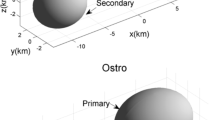Abstract
We derive the equations for the gravity assist manoeuvre in the general 2D case without the constraints of circular planetary orbits or widely different masses as assumed by Broucke (AIAA/AAS 1988) and obtain the slingshot conditions and maximum energy gain for arbitrary mass ratios of two colliding rigid bodies. Using the geometric view developed in an earlier paper by the authors (Rica da Silva, A., Lemos, J.P.S.: Am. J. Phys. 74, 584–590, 2006) the possible trajectories are computed for both attractive or repulsive interactions yielding a further insight on the slingshot mechanics and its parametrization. http://centra.ist.utl.pt/amaro/Collisions/Collisions.html. The general slingshot manoeuvre for arbitrary masses is explained as a particular case of the possible outcomes of attractive or repulsive binary collisions, and the correlation between asymptotic information and orbital parameters is obtained in general.
Similar content being viewed by others
References
Armellin R., Lavagna M. and Ercoli-Finzi A. (2006). Aero-gravity assist maneuvers: controlled dynamics modeling and optimization. Celest. Mech. Dyn. Astron. 95: 391–405
Asada H. (2007). An exact solution to determination of an open orbit. Celest. Mech. Dyn. Astron. 97: 151–164
Barger, V., Olsson, M.: Classical Mechanics: A Modern Perspective. McGraw-Hill (1995)
Barrabés, E., Gómez, G., Rodríguez-Canabal, J.: Advanced topics in astrodynamics. http://www.ieec.fcr.es/astro04/notes/gravity.pdf. Barcelona, July 2004
Broucke, R.A.: The Celestial Mechanics of gravity assist. In: American Institute of Aeronautics and Astronautics, editor, AIAA/AAS Astrodynamics Conference, Minneapolis, MN, Aug. 15–17, 1988, number (A88-50352 21-13) in Technical Papers, pp. 69–78, August 1988
Dykla J.J., Cacioppo R. and Gangopadhyaya A. (2004). Gravitational slingshot. Am. J. Phys. 72(5): 619–621
Epstein K.J. (2005). Shortcut to the slingshot effect. Am. J. Phys. 73: 362
Johnson, R.C.:The slingshot effect. http://maths.dur.ac.uk/dma0rcj/Psling/sling.pdf. (2003)
Johnson W.R. and Longuski J.M. (2002). Design of aerogravity-assist trajectories. J. Spacecr. Rockets 39(1): 23–30
Labunsky, A.V., Papkov, O.V., Sukhanov, K.G.: Multiple Gravity Assist Interplanetary Trajectories, vol. 2 of Earth Space Institute Book Series on Public and Private Sector Interest in Space. TF-CRC (1988). ISBN 90-5699090-X
Longuski J.M. and Williams S.N. (1991). Automated design of gravity-assist trajectories to mars and the outer planets. Celest. Mech. Dyn. Astron. 52: 207–220
Longuski, J.M., Fischbach, E., Scheeres D.J.: Deflection of spacecraft trajectories as a new test of general relativity. Phys. Rev. Lett. 86(14), (2001)
Malyshev V.V., Usachov V.E. and Tychinskii Y.D. (2003). Solar probe mission with multiple gravity-assist maneuvers realized with conversion launchers. Cosmic Res. 41(5): 431–442
Miller, J.K., Weeks, C.J.: Application of Tisserand’s criterion to the design of gravity assist trajectories. In: AIAA/AAS Astrodynamics Specialist Conference and Exhibit, AIAA 2002-4717, August 2002
Ocampo C.A. (2003). Transfers to earth centered orbits via lunar gravity assist. Acta. Astron. 52: 173–179
Racca G.D. (2003). New challenges to trajectory design by the use of electric propulsion and other new means of wandering in the solar system. Celes. Mech. Dyn. Astron. 85: 1–24
Rica da Silva, A.: 2D elastic collision parametrization (An Interactive Java Applet). http://centra.ist.utl.pt/amaro/Collisions/Collisions.html (2005)
Rica da Silva A. and Lemos J.P.S. (2006). Geometric parametrization of binary elastic collisions. Am. J. Phys. 74(7): 584–590
Roy, A.E.: Orbital Motion. Institute of Physics Publ. (2005)
Saslaw W.C., Valtonen M.J. and Aarseth S.J. (1974). The gravitational slingshot and the structure of extragalactic radio sources. Astrophys. J. 190: 253–270
Van Allen J.A. (2003). Gravitational assist in Celestial Mechanics-a tutorial. Am. J. Phys. 71(5): 448–451
Wiesel, W.E.: Spaceflight Dynamics. McGraw-Hill (1997)
Author information
Authors and Affiliations
Corresponding author
Rights and permissions
About this article
Cite this article
Rica da Silva, A.J., Lemos, J.P.S. Binary collisions and the slingshot effect. Celestial Mech Dyn Astr 100, 191–208 (2008). https://doi.org/10.1007/s10569-007-9114-5
Received:
Revised:
Accepted:
Published:
Issue Date:
DOI: https://doi.org/10.1007/s10569-007-9114-5




